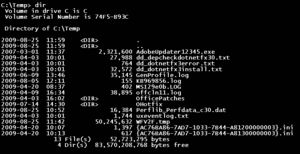Directory (computing): Difference between revisions
m Reverted edits by 74.229.243.117 to last revision by 203.4.200.254 (HG) |
m robot Modifying: ru:Каталог (файловая система), sv:Katalog (datorteknik) |
||
| Line 70: | Line 70: | ||
[[pl:Katalog (system plików)]] |
[[pl:Katalog (system plików)]] |
||
[[pt:Diretório (informática)]] |
[[pt:Diretório (informática)]] |
||
[[ru: |
[[ru:Каталог (файловая система)]] |
||
[[simple:Folder (computing)]] |
[[simple:Folder (computing)]] |
||
[[sk:Adresár]] |
[[sk:Adresár]] |
||
[[sr:Директоријум]] |
[[sr:Директоријум]] |
||
[[fi:Hakemisto]] |
[[fi:Hakemisto]] |
||
[[sv:Katalog]] |
[[sv:Katalog (datorteknik)]] |
||
[[uk:Каталог (файлова система)]] |
[[uk:Каталог (файлова система)]] |
||
[[zh:目录 (文件系统)]] |
[[zh:目录 (文件系统)]] |
||
Revision as of 12:09, 17 March 2010

Folder, directory[1], catalog, or drawer[2], in computing, is a virtual container within a digital file system, in which groups of computer files and other folders can be kept and organized.
A typical file system may contain thousands (or even hundreds of thousands) of folders. Files are kept organized by storing related files in the same folder. A folder contained inside another folder is called a subfolder of that folder. Together, the folders form a hierarchy, or tree structure.
Overview
Historically, and even on some modern embedded devices, the file systems either have no support for folders at all or only have a flat directory structure, meaning subfolders are not allowed; there is only a group of top-level folders each containing files. The first popular fully general hierarchical file system was that of Multics. This type of file system was an early research interest of Dennis Ritchie.
In modern times in Unix-like systems, especially Linux, folders structure is defined by the Filesystem Hierarchy Standard.
In many operating systems, programs have an associated working directory in which they execute. Typically file names accessed by the program are assumed to reside within this folder if the file names are not specified with an explicit folder name.
Some operating systems restrict a user's access to only their home directory or project folder, thus isolating their activities from all other users.
On Unix, folders are regarded as a type of file.[3]
The folder metaphor

The name folder, presenting an analogy to the file folder used in offices, and used originally by Apple Lisa[4], is used in almost all modern operating systems' desktop environments. Folders are often depicted with icons which visually resemble physical file folders.
Strictly speaking, there is a difference between a directory which is a file system concept, and the graphical user interface metaphor that is used to represent it (a folder). For example, Microsoft Windows uses the concept of special folders to help present the contents of the computer to the user in a fairly consistent way that frees the user from having to deal with absolute directory paths, which can vary between versions of Windows, and between individual installations.
If one is referring to a container of documents, the term folder is more appropriate. The term directory refers to the way a structured list of document files and folders is stored on the computer. It is comparable to a telephone directory that contains lists of names, numbers and addresses and does not contain the actual documents themselves.
See also
|
|
References
- ^ "With the introduction of Windows 95, Microsoft started referring to directories as folders." (Murach's C# 2005, page 34)
- ^ Name used in AmigaOS Workbench.
- ^ "Everything is a File" (Unix System Administration Independent Learning)
- ^ http://blog.modernmechanix.com/2008/05/29/the-lisa-computer-system-apple-designs-a-new-kind-of-machine/ "Apple Designs a New Kind of Machine"
External links
- Definition of directory by The Linux Information Project (LINFO)
